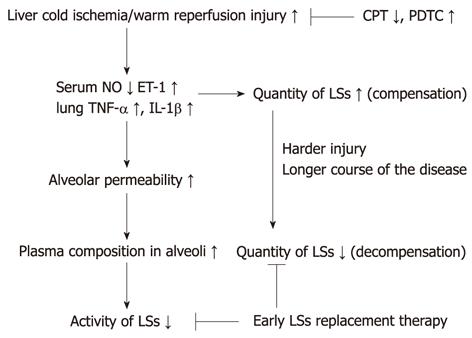Copyright
©2012 Baishideng Publishing Group Co.
World J Gastroenterol. Jan 28, 2012; 18(4): 323-330
Published online Jan 28, 2012. doi: 10.3748/wjg.v18.i4.323
Published online Jan 28, 2012. doi: 10.3748/wjg.v18.i4.323
Figure 6 A schematic diagram for the mechanism of lung surfactants in liver-transplantation-related acute lung injury.
With prolonged CPT of donor liver, the cold ischemia/warm reperfusion injury increased, inducing an imbalance of serum NO/ET-1 levels and production of TNF-α and IL-1β in lungs. Consequently, alveolar permeability increased, and the plasma composition in the alveoli inactivated the lung surfactants (LSs). In the early stage of ALI, LSs increased in compensation, but in the decompensation stage, the level of LSs decreased, and ALI was aggravated. Shorter CPT or using PDTC may reduce ALI, and surfactant replacement therapy at an earlier stage may be useful in the treatment of ALI. PDTC: Pyrrolidinedithiocarbamate; CPT: Cold preservation time; TNF: Tumor necrosis factor; IL: Interleukin; ALI: Acute lung injury; NO: Nitric oxide; ET: Endothelin.
- Citation: Jiang A, Liu C, Liu F, Song YL, Li QY, Yu L, Lv Y. Liver cold preservation induce lung surfactant changes and acute lung injury in rat liver transplantation. World J Gastroenterol 2012; 18(4): 323-330
- URL: https://www.wjgnet.com/1007-9327/full/v18/i4/323.htm
- DOI: https://dx.doi.org/10.3748/wjg.v18.i4.323









